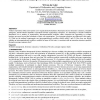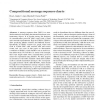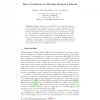ACSD
1998
IEEE
14 years 11 months ago
1998
IEEE
Today's corporations often must operate across organizational boundaries. Phenomena such as electronic commerce, extended enterprises, and the Internet stimulate cooperation ...
TACAS
2001
Springer
14 years 11 months ago
2001
Springer
Abstract. A message sequence chart (MSC) is a standard notation for describing the interaction between communicating objects. It is popular among the designers of communication pro...
101
click to vote
FOSSACS
2001
Springer
14 years 11 months ago
2001
Springer
Hierarchical Message Sequence Charts are a well-established formalism to specify telecommunication protocols. In this model, numerous undecidability results were obtained recently ...
CSR
2010
Springer
14 years 12 months ago
2010
Springer
Abstract. We introduce dynamic communicating automata (DCA), an extension of communicating finite-state machines that allows for dynamic creation of processes. Their behavior can ...
VL
2003
IEEE
15 years 10 days ago
2003
IEEE
The recent major revision of the UML (see [4]) has introduced significant changes and additions. In particular, Message Sequence Charts (MSC) according to the ISO standard (see [...
EVOW
2004
Springer
15 years 14 days ago
2004
Springer
An evolutionary approach to design communication protocols from scenario-based specifications is presented. It enables to automatically generate finite-state models of protocol ent...
APLAS
2005
ACM
15 years 19 days ago
2005
ACM
Message Sequence Charts (MSCs) are a graphical language for the description of scenarios in terms of message exchanges between communicating components in a distributed environment...
TACAS
2007
Springer
15 years 1 months ago
2007
Springer
This paper is concerned with bridging the gap between requirements, provided as a set of scenarios, and conforming design models. The novel aspect of our approach is to exploit lea...
FSTTCS
2007
Springer
15 years 1 months ago
2007
Springer
We examine a bidirectional Propositional Dynamic Logic (PDL) for message sequence charts (MSCs) extending LTL and TLC− . Every formula is translated into an equivalent communicat...
CONCUR
2007
Springer
15 years 1 months ago
2007
Springer
Scenario languages based on Message Sequence Charts (MSCs) have been widely studied in the last decade [21,20,3,15,12,19,14]. The high expressive power of MSCs renders many basic ...





